Principles of Business Governance: Case Analysis of Camita and Mathew
VerifiedAdded on 2023/01/20
|6
|1346
|67
Case Study
AI Summary
This assignment analyzes a case study involving Camita, a car dealer, and Mathew, a customer, focusing on principles of business governance and contract law. The core issue revolves around misrepresentation: whether statements made by Camita regarding a car's mileage and accident history were terms or representations within the contract. The analysis delves into legal concepts, including the distinction between terms and representations, and the elements required to establish misrepresentation. Key cases like Bannerman v. White, Dick Bentley Productions Ltd v. Harold Smith (Motors) Ltd, and Long v Lloyd are examined to determine if Camita's statements were terms and if they constituted misrepresentation. The application of these principles helps to determine if Mathew can claim damages. The court would likely allow Mathew to recover $4,000 from Camita as remedy for the misrepresentation. The assignment also explores the remedies available for breach of contract, including rescission and monetary damages, and how the court would apply them in the given situation. The conclusion states that the court would allow Mathew to recover $4,000 from Camita.
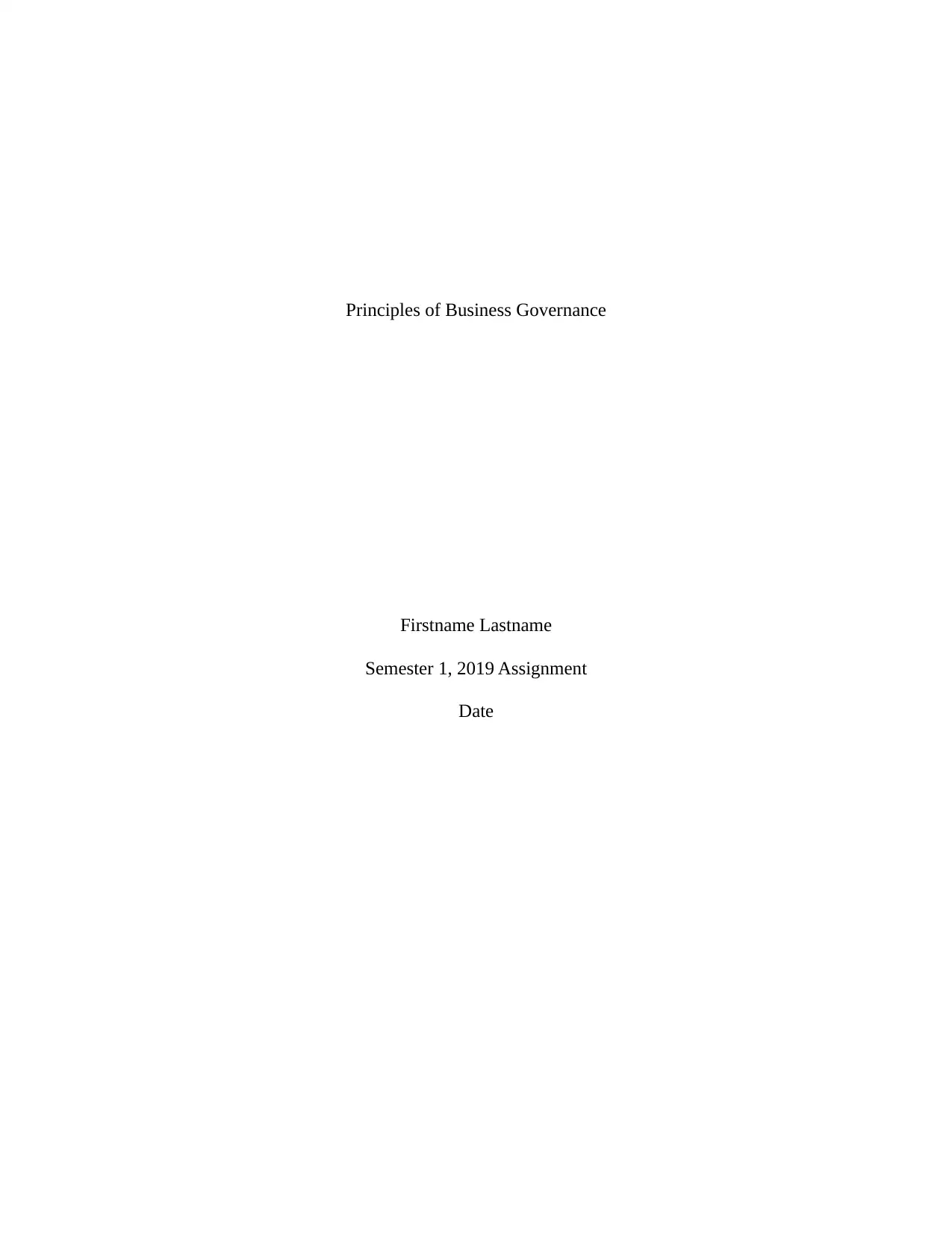
Principles of Business Governance
Firstname Lastname
Semester 1, 2019 Assignment
Date
Firstname Lastname
Semester 1, 2019 Assignment
Date
Paraphrase This Document
Need a fresh take? Get an instant paraphrase of this document with our AI Paraphraser
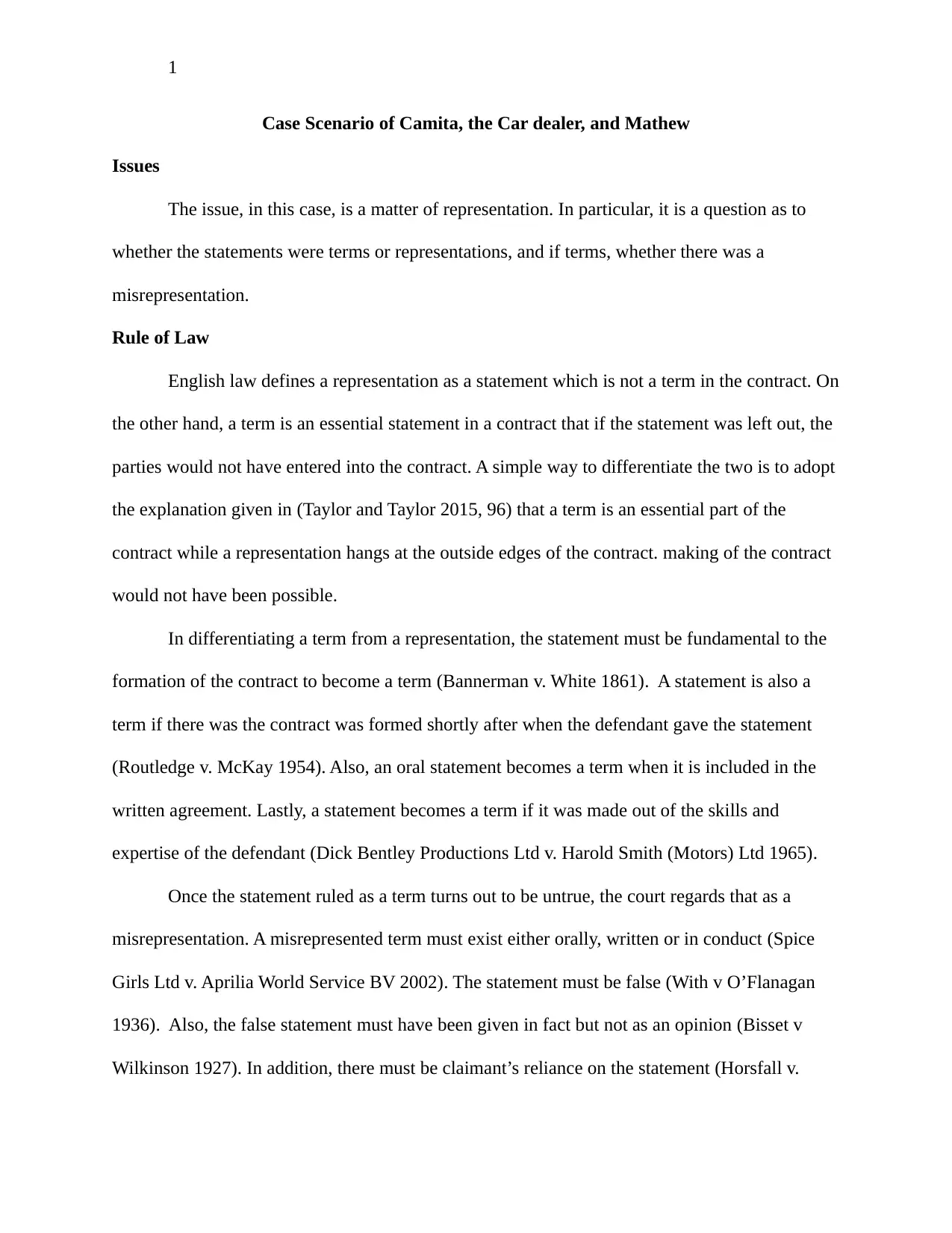
1
Case Scenario of Camita, the Car dealer, and Mathew
Issues
The issue, in this case, is a matter of representation. In particular, it is a question as to
whether the statements were terms or representations, and if terms, whether there was a
misrepresentation.
Rule of Law
English law defines a representation as a statement which is not a term in the contract. On
the other hand, a term is an essential statement in a contract that if the statement was left out, the
parties would not have entered into the contract. A simple way to differentiate the two is to adopt
the explanation given in (Taylor and Taylor 2015, 96) that a term is an essential part of the
contract while a representation hangs at the outside edges of the contract. making of the contract
would not have been possible.
In differentiating a term from a representation, the statement must be fundamental to the
formation of the contract to become a term (Bannerman v. White 1861). A statement is also a
term if there was the contract was formed shortly after when the defendant gave the statement
(Routledge v. McKay 1954). Also, an oral statement becomes a term when it is included in the
written agreement. Lastly, a statement becomes a term if it was made out of the skills and
expertise of the defendant (Dick Bentley Productions Ltd v. Harold Smith (Motors) Ltd 1965).
Once the statement ruled as a term turns out to be untrue, the court regards that as a
misrepresentation. A misrepresented term must exist either orally, written or in conduct (Spice
Girls Ltd v. Aprilia World Service BV 2002). The statement must be false (With v O’Flanagan
1936). Also, the false statement must have been given in fact but not as an opinion (Bisset v
Wilkinson 1927). In addition, there must be claimant’s reliance on the statement (Horsfall v.
Case Scenario of Camita, the Car dealer, and Mathew
Issues
The issue, in this case, is a matter of representation. In particular, it is a question as to
whether the statements were terms or representations, and if terms, whether there was a
misrepresentation.
Rule of Law
English law defines a representation as a statement which is not a term in the contract. On
the other hand, a term is an essential statement in a contract that if the statement was left out, the
parties would not have entered into the contract. A simple way to differentiate the two is to adopt
the explanation given in (Taylor and Taylor 2015, 96) that a term is an essential part of the
contract while a representation hangs at the outside edges of the contract. making of the contract
would not have been possible.
In differentiating a term from a representation, the statement must be fundamental to the
formation of the contract to become a term (Bannerman v. White 1861). A statement is also a
term if there was the contract was formed shortly after when the defendant gave the statement
(Routledge v. McKay 1954). Also, an oral statement becomes a term when it is included in the
written agreement. Lastly, a statement becomes a term if it was made out of the skills and
expertise of the defendant (Dick Bentley Productions Ltd v. Harold Smith (Motors) Ltd 1965).
Once the statement ruled as a term turns out to be untrue, the court regards that as a
misrepresentation. A misrepresented term must exist either orally, written or in conduct (Spice
Girls Ltd v. Aprilia World Service BV 2002). The statement must be false (With v O’Flanagan
1936). Also, the false statement must have been given in fact but not as an opinion (Bisset v
Wilkinson 1927). In addition, there must be claimant’s reliance on the statement (Horsfall v.
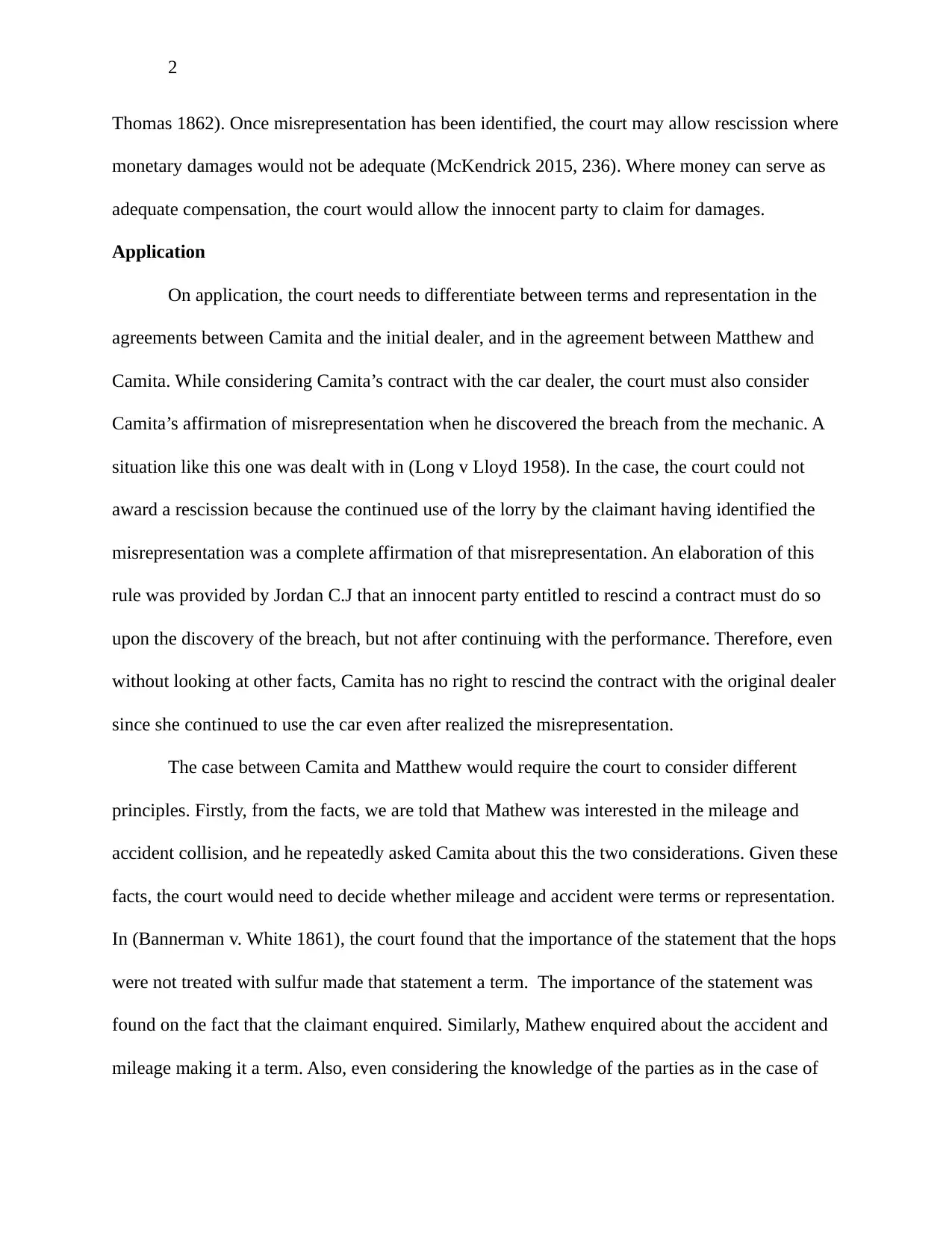
2
Thomas 1862). Once misrepresentation has been identified, the court may allow rescission where
monetary damages would not be adequate (McKendrick 2015, 236). Where money can serve as
adequate compensation, the court would allow the innocent party to claim for damages.
Application
On application, the court needs to differentiate between terms and representation in the
agreements between Camita and the initial dealer, and in the agreement between Matthew and
Camita. While considering Camita’s contract with the car dealer, the court must also consider
Camita’s affirmation of misrepresentation when he discovered the breach from the mechanic. A
situation like this one was dealt with in (Long v Lloyd 1958). In the case, the court could not
award a rescission because the continued use of the lorry by the claimant having identified the
misrepresentation was a complete affirmation of that misrepresentation. An elaboration of this
rule was provided by Jordan C.J that an innocent party entitled to rescind a contract must do so
upon the discovery of the breach, but not after continuing with the performance. Therefore, even
without looking at other facts, Camita has no right to rescind the contract with the original dealer
since she continued to use the car even after realized the misrepresentation.
The case between Camita and Matthew would require the court to consider different
principles. Firstly, from the facts, we are told that Mathew was interested in the mileage and
accident collision, and he repeatedly asked Camita about this the two considerations. Given these
facts, the court would need to decide whether mileage and accident were terms or representation.
In (Bannerman v. White 1861), the court found that the importance of the statement that the hops
were not treated with sulfur made that statement a term. The importance of the statement was
found on the fact that the claimant enquired. Similarly, Mathew enquired about the accident and
mileage making it a term. Also, even considering the knowledge of the parties as in the case of
Thomas 1862). Once misrepresentation has been identified, the court may allow rescission where
monetary damages would not be adequate (McKendrick 2015, 236). Where money can serve as
adequate compensation, the court would allow the innocent party to claim for damages.
Application
On application, the court needs to differentiate between terms and representation in the
agreements between Camita and the initial dealer, and in the agreement between Matthew and
Camita. While considering Camita’s contract with the car dealer, the court must also consider
Camita’s affirmation of misrepresentation when he discovered the breach from the mechanic. A
situation like this one was dealt with in (Long v Lloyd 1958). In the case, the court could not
award a rescission because the continued use of the lorry by the claimant having identified the
misrepresentation was a complete affirmation of that misrepresentation. An elaboration of this
rule was provided by Jordan C.J that an innocent party entitled to rescind a contract must do so
upon the discovery of the breach, but not after continuing with the performance. Therefore, even
without looking at other facts, Camita has no right to rescind the contract with the original dealer
since she continued to use the car even after realized the misrepresentation.
The case between Camita and Matthew would require the court to consider different
principles. Firstly, from the facts, we are told that Mathew was interested in the mileage and
accident collision, and he repeatedly asked Camita about this the two considerations. Given these
facts, the court would need to decide whether mileage and accident were terms or representation.
In (Bannerman v. White 1861), the court found that the importance of the statement that the hops
were not treated with sulfur made that statement a term. The importance of the statement was
found on the fact that the claimant enquired. Similarly, Mathew enquired about the accident and
mileage making it a term. Also, even considering the knowledge of the parties as in the case of
⊘ This is a preview!⊘
Do you want full access?
Subscribe today to unlock all pages.

Trusted by 1+ million students worldwide
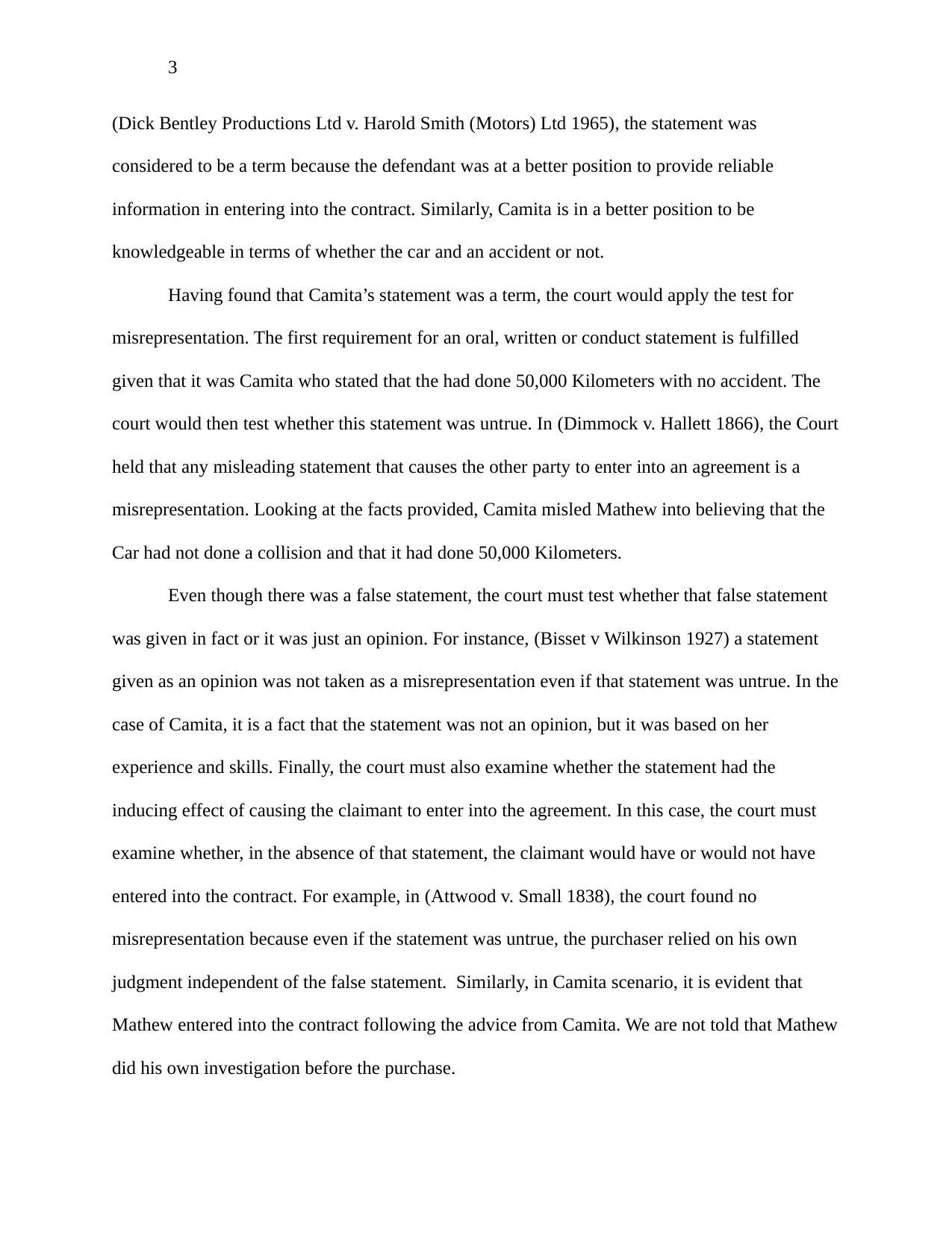
3
(Dick Bentley Productions Ltd v. Harold Smith (Motors) Ltd 1965), the statement was
considered to be a term because the defendant was at a better position to provide reliable
information in entering into the contract. Similarly, Camita is in a better position to be
knowledgeable in terms of whether the car and an accident or not.
Having found that Camita’s statement was a term, the court would apply the test for
misrepresentation. The first requirement for an oral, written or conduct statement is fulfilled
given that it was Camita who stated that the had done 50,000 Kilometers with no accident. The
court would then test whether this statement was untrue. In (Dimmock v. Hallett 1866), the Court
held that any misleading statement that causes the other party to enter into an agreement is a
misrepresentation. Looking at the facts provided, Camita misled Mathew into believing that the
Car had not done a collision and that it had done 50,000 Kilometers.
Even though there was a false statement, the court must test whether that false statement
was given in fact or it was just an opinion. For instance, (Bisset v Wilkinson 1927) a statement
given as an opinion was not taken as a misrepresentation even if that statement was untrue. In the
case of Camita, it is a fact that the statement was not an opinion, but it was based on her
experience and skills. Finally, the court must also examine whether the statement had the
inducing effect of causing the claimant to enter into the agreement. In this case, the court must
examine whether, in the absence of that statement, the claimant would have or would not have
entered into the contract. For example, in (Attwood v. Small 1838), the court found no
misrepresentation because even if the statement was untrue, the purchaser relied on his own
judgment independent of the false statement. Similarly, in Camita scenario, it is evident that
Mathew entered into the contract following the advice from Camita. We are not told that Mathew
did his own investigation before the purchase.
(Dick Bentley Productions Ltd v. Harold Smith (Motors) Ltd 1965), the statement was
considered to be a term because the defendant was at a better position to provide reliable
information in entering into the contract. Similarly, Camita is in a better position to be
knowledgeable in terms of whether the car and an accident or not.
Having found that Camita’s statement was a term, the court would apply the test for
misrepresentation. The first requirement for an oral, written or conduct statement is fulfilled
given that it was Camita who stated that the had done 50,000 Kilometers with no accident. The
court would then test whether this statement was untrue. In (Dimmock v. Hallett 1866), the Court
held that any misleading statement that causes the other party to enter into an agreement is a
misrepresentation. Looking at the facts provided, Camita misled Mathew into believing that the
Car had not done a collision and that it had done 50,000 Kilometers.
Even though there was a false statement, the court must test whether that false statement
was given in fact or it was just an opinion. For instance, (Bisset v Wilkinson 1927) a statement
given as an opinion was not taken as a misrepresentation even if that statement was untrue. In the
case of Camita, it is a fact that the statement was not an opinion, but it was based on her
experience and skills. Finally, the court must also examine whether the statement had the
inducing effect of causing the claimant to enter into the agreement. In this case, the court must
examine whether, in the absence of that statement, the claimant would have or would not have
entered into the contract. For example, in (Attwood v. Small 1838), the court found no
misrepresentation because even if the statement was untrue, the purchaser relied on his own
judgment independent of the false statement. Similarly, in Camita scenario, it is evident that
Mathew entered into the contract following the advice from Camita. We are not told that Mathew
did his own investigation before the purchase.
Paraphrase This Document
Need a fresh take? Get an instant paraphrase of this document with our AI Paraphraser
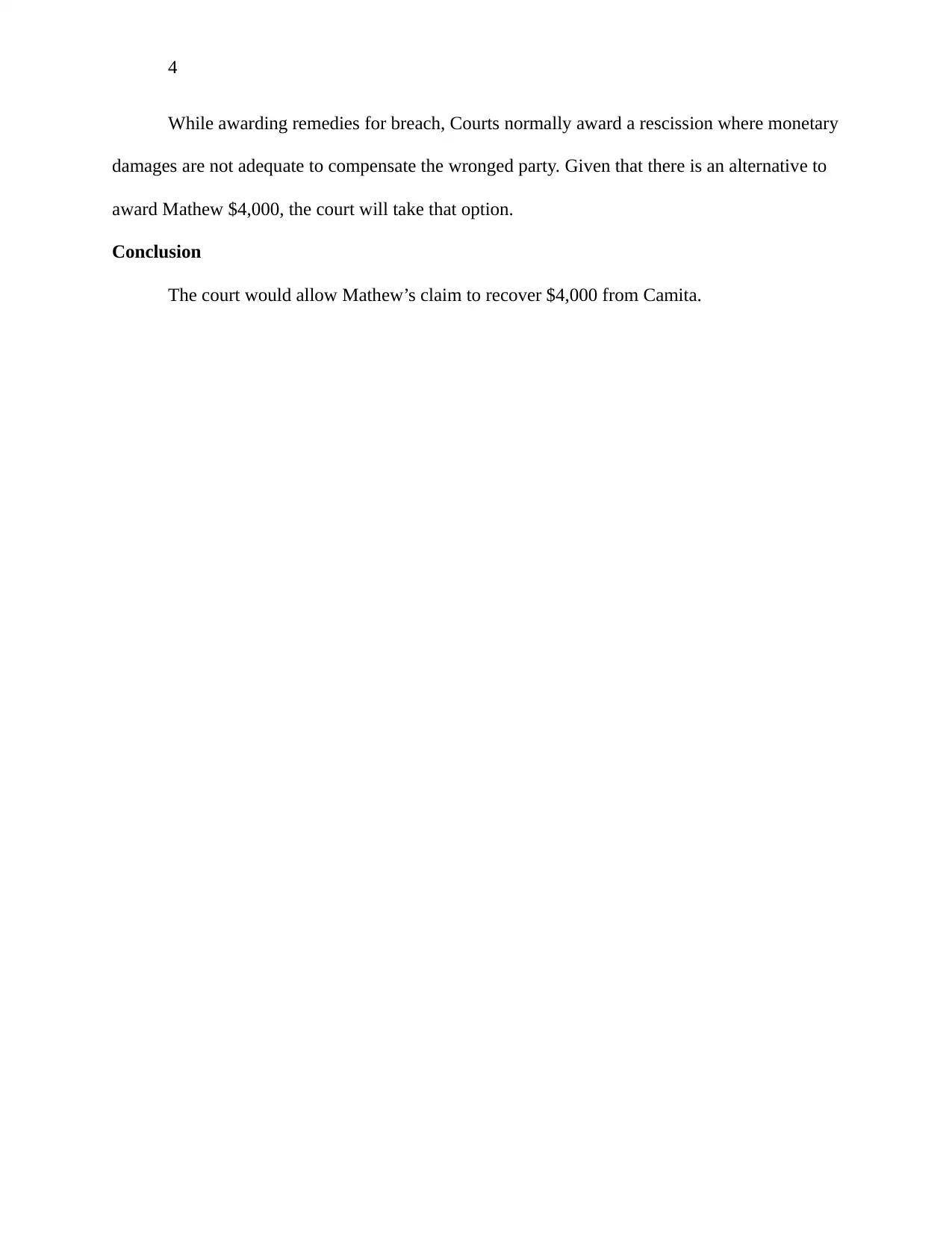
4
While awarding remedies for breach, Courts normally award a rescission where monetary
damages are not adequate to compensate the wronged party. Given that there is an alternative to
award Mathew $4,000, the court will take that option.
Conclusion
The court would allow Mathew’s claim to recover $4,000 from Camita.
While awarding remedies for breach, Courts normally award a rescission where monetary
damages are not adequate to compensate the wronged party. Given that there is an alternative to
award Mathew $4,000, the court will take that option.
Conclusion
The court would allow Mathew’s claim to recover $4,000 from Camita.
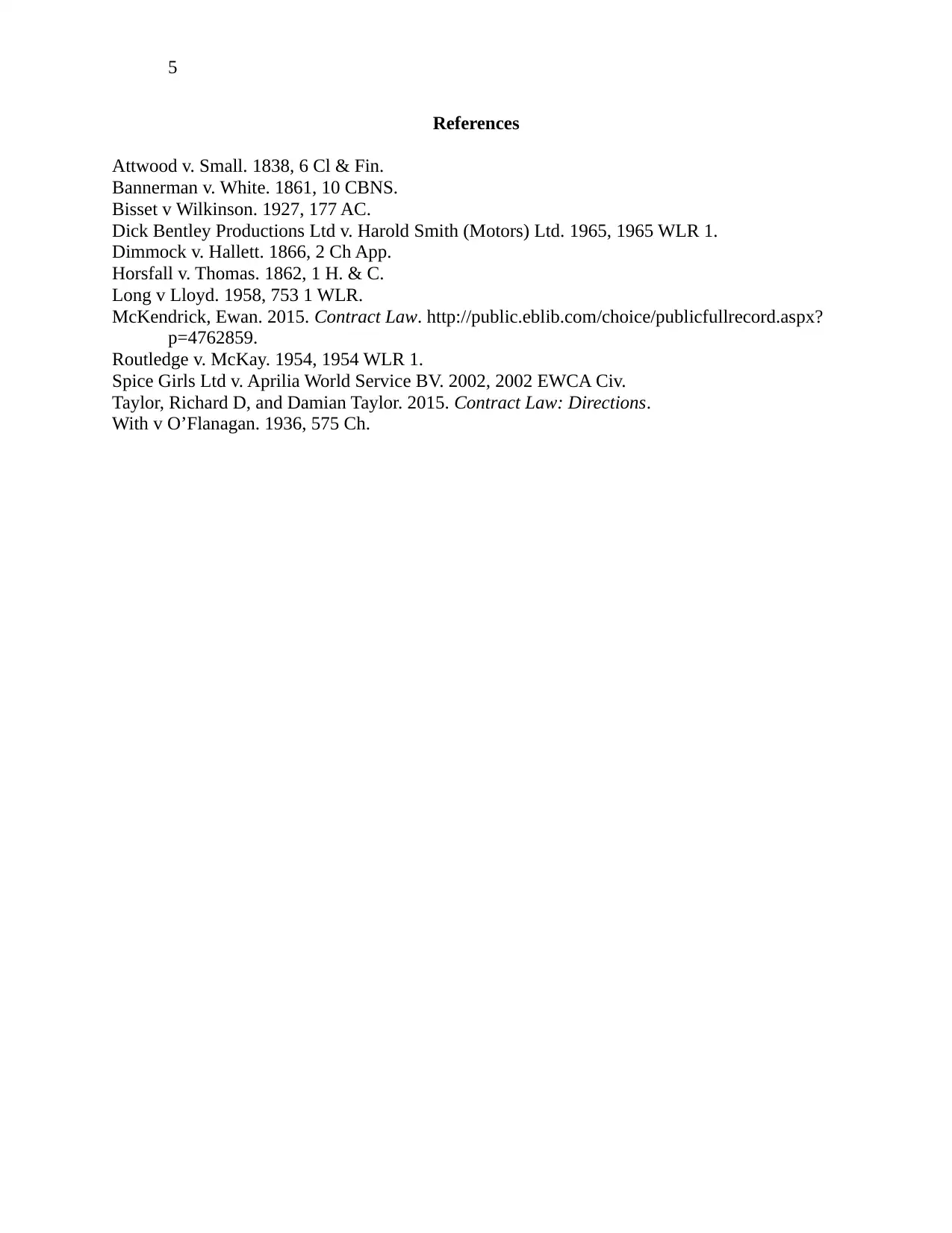
5
References
Attwood v. Small. 1838, 6 Cl & Fin.
Bannerman v. White. 1861, 10 CBNS.
Bisset v Wilkinson. 1927, 177 AC.
Dick Bentley Productions Ltd v. Harold Smith (Motors) Ltd. 1965, 1965 WLR 1.
Dimmock v. Hallett. 1866, 2 Ch App.
Horsfall v. Thomas. 1862, 1 H. & C.
Long v Lloyd. 1958, 753 1 WLR.
McKendrick, Ewan. 2015. Contract Law. http://public.eblib.com/choice/publicfullrecord.aspx?
p=4762859.
Routledge v. McKay. 1954, 1954 WLR 1.
Spice Girls Ltd v. Aprilia World Service BV. 2002, 2002 EWCA Civ.
Taylor, Richard D, and Damian Taylor. 2015. Contract Law: Directions.
With v O’Flanagan. 1936, 575 Ch.
References
Attwood v. Small. 1838, 6 Cl & Fin.
Bannerman v. White. 1861, 10 CBNS.
Bisset v Wilkinson. 1927, 177 AC.
Dick Bentley Productions Ltd v. Harold Smith (Motors) Ltd. 1965, 1965 WLR 1.
Dimmock v. Hallett. 1866, 2 Ch App.
Horsfall v. Thomas. 1862, 1 H. & C.
Long v Lloyd. 1958, 753 1 WLR.
McKendrick, Ewan. 2015. Contract Law. http://public.eblib.com/choice/publicfullrecord.aspx?
p=4762859.
Routledge v. McKay. 1954, 1954 WLR 1.
Spice Girls Ltd v. Aprilia World Service BV. 2002, 2002 EWCA Civ.
Taylor, Richard D, and Damian Taylor. 2015. Contract Law: Directions.
With v O’Flanagan. 1936, 575 Ch.
⊘ This is a preview!⊘
Do you want full access?
Subscribe today to unlock all pages.

Trusted by 1+ million students worldwide
1 out of 6
Related Documents
Your All-in-One AI-Powered Toolkit for Academic Success.
+13062052269
info@desklib.com
Available 24*7 on WhatsApp / Email
![[object Object]](/_next/static/media/star-bottom.7253800d.svg)
Unlock your academic potential
Copyright © 2020–2025 A2Z Services. All Rights Reserved. Developed and managed by ZUCOL.





